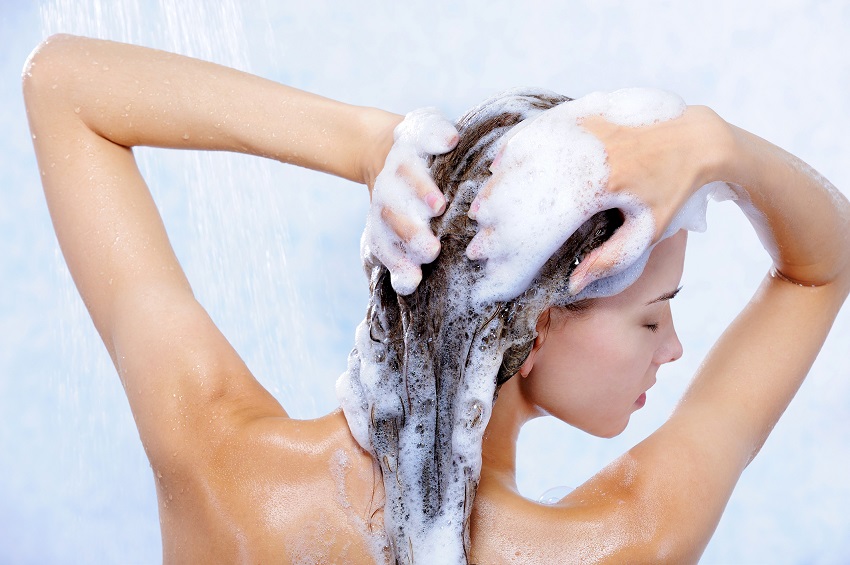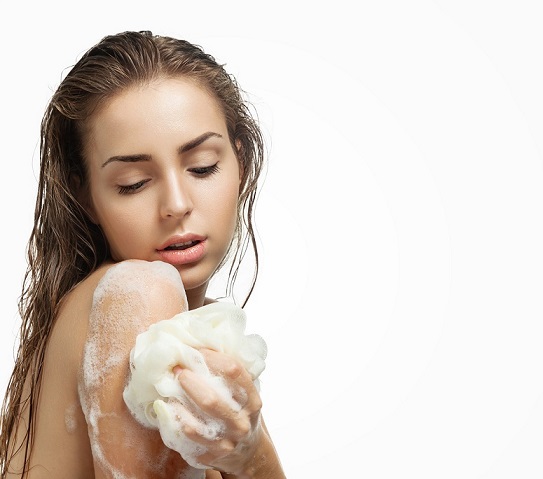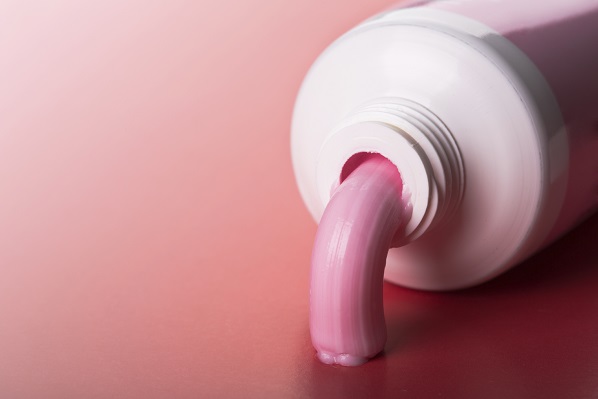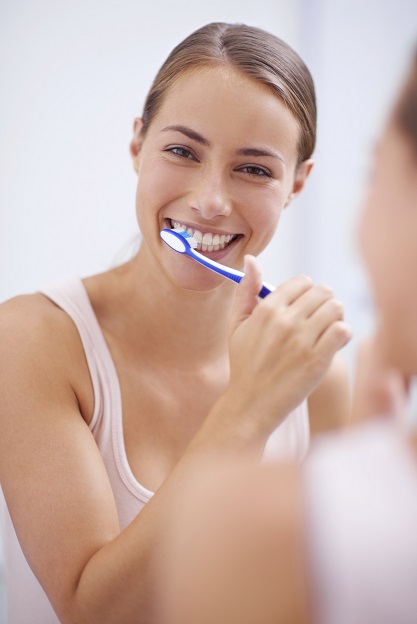
By far the most overlooked cause of acne is the multitude of chemicals and toxins hiding silently in our environment.
To name just a handful, you’ve got the fluoride in toothpaste and the BPA in plastic water bottles. There’s the heavy metals like cadmium on old crop fields and arsenic in apple juice, and last but not least, there’s the butyl paraben hiding in most women’s commercial makeup.
An unknowing acne patient can easily ingest hundreds of these toxins daily, small amounts of each which steadily accumulate and combine for a significant increase in inflammation. Such chemicals are a massive threat to both clear skin and vibrant and glowing skin.
Most importantly, these environmental toxins are a hidden and underestimated force, lurking under most acne patient’s noses.
There’s one chemical, however, which has roused the righteous fury of the acne-clearing underground: sodium lauryl sulfate, or SLS. A cosmetics chemical found in shampoo, toothpaste, and shower gel, with proven pore-clogging and irritating qualities.
What is sodium lauryl sulfate?
Sodium lauryl sulfate was originally a compound derived from coconut flesh, but its days of healthiness are long over. These days, SLS is an industrial detergent and surfactant, an ingredient that strips away molecules like grease and allows products to influence your hair, skin or gums more effectively. These properties make SLS perfect for industrial strength degreasers used on engines and heavy machinery – you can even buy raw SLS for degreasing your own car engine.
More commonly, SLS is a strong lathering agent, the reason for the white foaminess of countless products you’ve used during your life. Toothpaste, for example, would never foam up if it wasn’t for this chemical. The lather has advantages other than being fun, as the big bubbles penetrate the gaps between teeth more effectively, spreading the enamelising agents like fluoride into every inaccessible corner.
Since SLS is dirt cheap, this chemical can be found far and wide: in toothpaste, shampoo, mouthwash, shower gel, facial cleansers, and most items that foam up.
Sodium lauryl sulfate is currently one of the most common additives in personal care items. Check your toothpaste tube right now and see.
Note that sodium laureth sulfate is a different chemical, an easily confused alter ego that has fairly similar properties.
Irritation!
Firstly, sodium lauryl sulfate is one of the most notoriously irritating ingredients ever to grace cosmetics. Just an hour of SLS exposure causes cells to die, cracks to form in the skin, and irritation to be born.
The causes of this mayhem are simple: SLS is a protein denaturer. It attacks the cell membranes of skin cells, destabilising and inflaming your skin’s tissues…
…and the culprit behind the protein denaturing is SLS’s powerful surfectant properties, which are central to its powers as a cosmetics additive, yet strip away your skin’s healthy defences as a side effect. SLS is so notorious for inflammation that in studies on anti-inflammatory remedies, it’s effectively the gold standard for purposefully inducing inflammation.
The danger of SLS is two fold. Firstly, the mere presence of such a harsh substance causes your body to unleash a ferocious inflammatory response against it.
Read Annihilate Your Acne – get the diet that could transform your skin!
The timespan is particularly important, as a headful of shampoo flowing down your face for 60 seconds won’t expose your face to SLS for long. But 20 minutes of tiny shampoo residue is another story: that’s easily enough for the irritation to begin. What’s more, what feels like individual short, safe sessions can lead to sodium lauryl sulfate accumulating over many weeks, and with it the irritation.
Women are known to be significantly more sensitive to SLS than men. Individual men and women can be more sensitive than average too – some people experience explosive contact dermatitis instantly. Everybody, however, is in danger from regular contact.
Has shampoo ever left your scalp red and inflamed? Sodium lauryl sulfate and its fun-filled frothiness is the culprit. Have you ever noticed that toothpaste inflames your gums rather than leaving them a healthy pink colour? Sodium lauryl sulfate is why, combined with sodium fluoride.
Sodium lauryl sulfate is alkalising

Simple irritation is bad enough, but SLS also has more complex and subtle dangers. Firstly, sodium lauryl sulfate is an alkaline chemical, proven to increase your skin’s PH. The skin’s optimal PH ranges from 4.5 to 5.5, with kids having a higher PH to keep infections away while their immune systems develop. Excess alkalinity allows bacteria such as p.acnes to thrive, irritate your skin, and cause yet more acne.
Irritation is bad news for your skin tone, and will inflame existing acne, but the PH of sodium lauryl sulfate will help to create new pimples altogether. SLS won’t increase your skin’s alkalinity after a single shampoo session, but with consistent use, it easily could.
Then there’s a bonus danger of alkalinity – higher activity of proteases in the skin. Proteases are simply protein-digesting enzymes, which are healthy and natural, but able to lower collagen in excess. With too many proteases breaking down collagen, your acne will never heal properly. You’ll also develop weak skin and possibly age prematurely.
In human skin, protease activity peaks at PHs of around 7-8, with activity curtailed at healthy PHs of 5.5. SLS is easily capable of pulling your skin into this danger zone.
Not just an irritant!
The second most feared danger of sodium lauryl sulfate is its pore-clogging powers. After using a foaming cleanser blessed with the presence of SLS, your skin will initially feel clean, rubbery, and what many call squeaky. This cleanliness comes from the surfectant properties stripping away your skin’s oil without an ounce of mercy.
SLS is specifically designed to remove oils, being added to washing up liquid and degreasers. SLS doesn’t differentiate between a plate of recently eaten steak or the sebum on your face; it strips away all oils in its path. To compensate, your sebaceous glands go wild and pump out more oil. The drying properties backfire massively, and consequently, sodium lauryl sulfate has a comedogenic rating of 5 out of 5, despite being a chemical rather than an oil. That’s even higher than its official irritation score of 2.
Next – the 6 best vitamins and minerals for naturally clear skin
Somehow, SLS is even able to increase the quantity of sebocytes, the sebum-producing cells in your skin. This may be another compensatory response to the powerful drying properties.
What’s more, fats are vital to the function of your skin barrier, being used to manufacture ceramides and other structural compounds. Because of this, SLS is known to increase trans-epidermal water loss (TEWL). Sodium lauryl sulfate dries out your skin not only by stripping fats away, but also by wreaking your skin’s ability to retain moisture.
Interestingly, SLS is proven to be more irritating in people whose skin is already compromised, including sufferers of atopic dermatitis and weakened skin barrier function. Clear-skinned people might breathe a sigh of relief at that news, but SLS itself weakens the skin barrier. Many people speak of using shampoo for months without a trace of irritation, before suddenly developing a sodium lauryl sulfate sensitivity. The cumulative damage is almost certainly why. SLS will continuously weaken your skin until the dam finally breaks and irritation finally kicks in.
Make no mistake: the dangers of sodium lauryl sulfate go far beyond basic contact irritation.
Are there any internal dangers?

What about oral SLS? What happens when this chemical enters your bloodstream? SLS in toothpaste can penetrate the membranes in your mouth, and of course, you could accidentally swallow it. Sodium lauryl sulfate can also be absorbed transdermally, passing through the skin and into the blood vessels.
What’s mysterious compared to mercury or fluoride is where SLS is toxic inside the body. There’s a strange lack of evidence on common chemical dangers behind acne such as spiking inflammation or generating free radicals. Because of its cosmetics role, SLS has understandably been tested far more in topical studies.
We know that SLS is often contaminated with 1,4 Dioxine, a potent carcinogenic, and nitrosamines, mutant compounds which generate free radicals inside the body. However, this contamination isn’t an epidemic. The most hardcore anti-SLS zealots even claim that SLS causes cancer when the evidence is pretty flimsy (though nothing is inconceivable)…
…but there was no need to exaggerate anything, because sodium lauryl sulfate’s confirmed dangers are already horrific.
For acne, one of the biggest problems with any artificial chemical is glutathione depletion. Glutathione is one of the master antioxidants for acne, manufactured in most living bodily cells using a holy triumvirate of cysteine, glycine and selenium. However, there’s a also parallel detoxification form called glutathione-s-transferase, used to metabolise a wide variety of villains such as mercury, fluoride and BPA.
Most importantly, GST is constructed using the exact same ingredients as the antioxidant form. If your body is being pummelled by artificial chemicals and contaminants around the clock, your GST stocks will decline, and with it the supplies for one of the most important acne-clearing substances.
If its detoxification pathway relies on GST, then any chemical which isn’t proven to cause acne can still be damaging.
Zinc – the number one mineral for clear skin (reduces acne by 49.8%)
The spotlight thus swings to SLS, and indeed, this study confirmed that applying SLS to a patch of skin slowly depleted its local GST levels. There was no change after 6 hours, but after 48, the decline in glutathione-s-transferase became significant, suggesting that GST is indeed involved with the detoxification pathway of sodium lauryl sulfate.
Glutathione depletion is probably the single most overlooked danger of environmental chemicals. Other detoxification pathways exist, like the P450 enzyme which metabolises caffeine. But while not all environmental toxins have been tested, from what I’ve seen well over half are detoxified by GST. Many gurus deem certain chemicals to be safe because no pro-inflammatory or antioxidant-depleting side effects have been proven, but indirect glutathione depletion is rarely considered.
For acne, glutathione depletion is why I recommend avoiding as many chemical-filled cosmetics, pesticide-covered crops (apples and celery are two horrors) and personal care items as possible, including those with SLS.
Given how strongly it irritates the skin, there’s an automatic chance that the immune system assaults oral SLS with an inflammatory barrage anyway.
The real reason to go natural

What’s more, there’s so many other chemicals hiding around today that it’s a lost opportunity not to eliminate the ones which you do know about.
Just last week, an international study discovered that 72% of UK tap water samples contained tiny beads of plastic. Among 14 countries including the UK, US, Germany, France and Indonesia, the rate was 83%.
The danger of plastic is chiefly the highly inflammatory phthalates they contain, but the biggest danger is the implication of what other contaminants might be hiding. This applies to tap water, cosmetics, shampoo, agricultural crops and more. Fragrances in fabric softeners and perfumes don’t even have to be listed in the United States, much less the mutant volatile organic compounds they create (see this pillowcase article).
7 natural topical treatments which could transform your skin
A bunch of people insist that this is pure paranoia, but if you’re going to be paranoid about one phenomenon, then environmental chemicals are an excellent candidate. There’s so many diseases which are all-conquering in the 21st century – particularly breast cancer, dementia, low testosterone and of course, adult acne. The same people scratching their heads are the ones mumbling that chemical tap water is nothing to worry about.
When SLS is so easy to avoid, you should always seize the opportunity.
Your sodium lauryl sulfate master plan
Luckily, the opportunity is particularly easy to seize. Sodium lauryl sulfate cannot run and it cannot hide, for it is always given away by its lathery trail of white foam and bubbles. Learn the following tricks and wave goodbye to SLS forever:
Learn these alternative names – the negative reputation of sodium lauryl sulfate has spread so widely that manufacturers are desperate to hide it. Over 100 different names are now used. Some are ridiculously obvious, but some are sneakier.
The most common names are: olefin sulfate, sodium dodecyl sulphate (SDS), dodecyl sodium sulfate; lauryl sodium sulfate (how lazy can you get!), lauryl sulfate sodium salt, sodium n-dodecyl sulfate, sulfuric acid monododecyl ester sodium salt, and sodium dodecane sulfate. Sodium laureth sulfate is a subtly different chemical, but I would avoid this too, because it’s also highly irritating.
Avoid sodium coco sulfate – a recently introduced coconut form, commonly used in organic skincare products. It’s claimed to be healthy, but don’t be fooled! There’s little difference to SLS in its effects on health. Sodium coco sulfate is the definition of a marketing gimmick.
The only real difference is that the fatty acids at the beginning of the harsh manufacturing process are derived from coconuts. Ordinarily, isolated lauric acid is used to make SLS, being treated with chlorosulfonic acid among many other steps. With sodium coco sulfate, a blend of all the fatty acids from coconut is used.
Coconut fat is 50% lauric acid, but also contains myristic acid and palmitic acid. Sodium coco sulfate ends up with some other sulfates of fatty acids in the mix, but it’s still treated with blisteringly harsh acids and it still becomes a synthetic chemical. Most importantly, sodium coco sulfate still consists predominantly of sodium lauryl sulfate.
You may also see the words “derived from coconuts” alongside regular sodium lauryl sulfate. This means that the initial lauric acid (AKA, the “lauryl” part) was derived from coconut, which makes not a jolt of difference to the properties and safety for acne.
Be suspicious of lather – bubbles and foam doesn’t confirm harsh chemicals, but it’s an ominous warning sign. A few natural products like Dr Bronner’s castile soap lather up slightly, but rarely to the same eternally swelling extent as an SLS-fest. Check the ingredients list, and proceed to terminate SLS with neither pity nor remorse, remembering the new names.
Get an acne-friendly toothpaste – the toothpaste I recommend is a simple combination of baking soda and extra virgin coconut oil. Baking soda is proven to be antibacterial, in addition to alkaline, which deactivates the corrosive acids in your mouth. Coconut oil is also highly antibacterial, due to its 50% content of lauric acid. Melt the coconut oil with gentle heat (to avoid rancidifying the oil) and combine the two into a soft paste, for a mindlessly easy homemade trick.
Recently, however, a bunch of organic toothpastes have materialised. Dr Bronner’s sells a peppermint flavoured one, which consists of numerous natural antibacterial ingredients, including coconut oil and baking soda. There’s no SLS, no harsh fillers to speak of, and definitely no sodium fluoride. Amazon link here: Dr. Bronner’s Magic Soaps Toothpaste (Peppermint).
Get an acne-friendly shampoo, liquid hand wash, shower gel – for each of those products, I use small amounts of Dr Bronner’s liquid castile soap. It works so well that I’ve never seen the need for anything else.
Since everybody’s hair differs, and Dr Bronner’s occasionally irritates people, you might desire something different. The world of organic shampoos is wide and I’m far from an expert, but Dr Bronner’s leaves your hair weirdly soft, softer that a chemical shampoo with billions of dollars of research poured into it can dream of. Again, there’s no SLS or harsh fillers. Amazon link here: Dr. Bronner’s Peppermint Liquid Castille Soap.
Conclusion
Just as benzoyl peroxide or honey can never cure your acne alone, so too is SLS incapable of causing it alone.
What sodium lauryl sulfate can do is irritate your skin and make existing acne more inflamed. SLS can trash your skin in numerous ways: skin barrier function, sebum production, skin PH, and moisture loss.
Inside the body, there’s a strong chance that sodium lauryl sulfate will deplete glutathione. There’s no need to use sodium lauryl sulfate anyway. It literally leaves a trail of foam and bubbles wherever it steps and is easy to put to rest.
You might be angry or scared at first to realise how toxic chemicals like this are infesting society, but you should always see it as an opportunity. With thousands of chemicals lurking in the shadows, you now have thousands of ways to improve your skin.
The same applies to your diet. You might be horrified to discover that unbeknownst to you, you’re really digesting 200 grams of sugar per day. In reality, it should be the greatest news you’ve heard all month: fresh room for improvement has opened up.
Always remember that acne-clearing opportunities are everywhere.
NEXT: discover the root causes of acne and banish your pimples forever
Thanks for reading!

Hello,
First off, I just want to say great blog! I really like the fact that you take the time to research the topics you discuss and present them on your blog. I was wondering, what are your thoughts on oil cleansing for acne? I’ve been doing it for about 3 weeks and must admit that I really like it. I would like to hear your input on this subject. Thanks!
Thanks; the oil cleansing method depends completely on which oil you use. Using any natural oil will not cut it, because some popular ones like olive oil are overrated. Some strong oils for acne include: tamanu oil, with antibacterial and collagen increasing properties, grapeseed oil and argan oil, which are very high in vitamin E, and sea buckthorn oil, which is great for oily skin (despite sounding contradictory). It depends on what you’re trying to achieve, but a basic oil cleansing method which aims to achieve everything is inferior to knowing precisely what each oil achieves and acting on that.
thank you !!!!!!!!!!!!!!!!!!!!!!!!!!!!!!!!!!!! amazing research and for bringing light to this topic, i did not know about SLS being everywhere , this article has opened my eyes
I just came across this article. I’ve suffered with acne for almost all my life. At the beginning of this year, my mouth started to flare up so bad that even periodontists were confused on what it could be from. My gums would bleed, I’d cry when I brushed my teeth. It felt like I had mouth sores in every bit of my mouth. After doing a biopsy of my gum, we still came out with no answers. We assumed it was some sort of allergic reaction, but to what? In conversation, my periodontist randomly suggested I get toothpaste that doesn’t have SLS in. Just because it might be less painful when I brush my teeth. My mouth had completely healed, but we were unsure from what. Recently, I ran out of toothpaste and just picked up a normal tube. The first time in months that I was going to brush my teeth with SLS toothpaste. Within 3 days, my mouth had completely flared up again. Cracks in the corner of my mouth, sores, and it was just getting worse. I immediately changed toothpaste and it’s already getting better. So if that is what SLS does to my mouth, what can it be doing for my skin? This is such an eye opener and I’m going to switch to SLS free skincare products. Thank you!
The mouth is a great proxy for the rest of your skin, so the chances are high that you have a particular sensitivity. Good luck!
Could we also use baking soda as a low-cost organic shampoo option? Or do you think it would strip away too many essential oils from our skin?